Failing Building is a historic building in Portland, Oregon, U.S.
Failing Building may also refer to these historic buildings in Portland, Oregon, United States, named for the Failing family:

The Portland Art Museum (PAM) is an art museum in downtown Portland, Oregon, United States. The Portland Art Museum has 240,000 square feet, with more than 112,000 square feet of gallery space. The museum’s permanent collection has over 42,000 works of art. PAM features a center for Native American art, a center for Northwest art, a center for modern and contemporary art, permanent exhibitions of Asian art, and an outdoor public sculpture garden. The Northwest Film Center is also a component of Portland Art Museum.
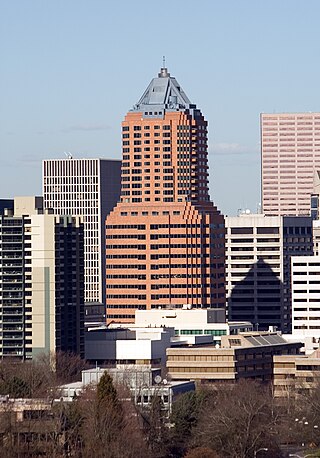
Portland architecture includes a number of notable buildings, a wide range of styles, and a few notable pioneering architects.

Henry Winslow Corbett was an American businessman, politician, civic benefactor, and philanthropist in the state of Oregon. A native of Massachusetts, he spent his early life in the East and New York before moving to the Oregon Territory. He was a prominent figure in the early development of Portland, Oregon, and was involved in numerous business ventures there, starting in general merchandise. His interests later included banking, finance, insurance, river shipping, stage lines, railways, telegraph, iron and steel and the erection of Portland downtown buildings among other enterprises. A Republican, he served as a United States senator from 1867 to 1873.
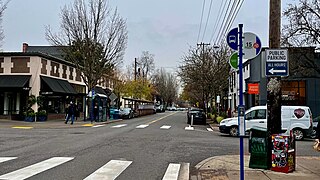
The Northwest District is a densely populated retail and residential neighborhood in the northwest section of Portland, Oregon, United States. Craftsman-style and Old Portland-style houses are packed tightly together with old apartment buildings and new condominiums, within walking distance of restaurants, bars, and shops. The Portland Streetcar's first line terminates there, connecting the district to the Pearl District, Downtown Portland and points south to the South Waterfront, and several TriMet bus lines also serve the district.

The National University of Natural Medicine (NUNM) is a private university of naturopathic medicine and Classical Chinese medicine located in Portland, Oregon. The school has approximately 553 students.
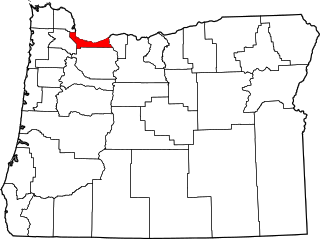
The following list presents the full set of National Register of Historic Places listings in Multnomah County, Oregon. However, please see separate articles for listings in each of Portland's six quadrants.

The Kimpton Hotel Vintage Portland, historically known as the Imperial Hotel and also as The Plaza Hotel, is a historic hotel building in downtown Portland, Oregon, United States. It was completed in 1894 and was listed on the National Register of Historic Places in 1985 as "Imperial Hotel". Since 2015, the building has been in use as the Kimpton Hotel Vintage Portland, and prior to then it had been known as the Hotel Vintage Plaza since 1991.

The Seward Hotel, also known as the Governor Hotel, is a historic hotel building in downtown Portland, Oregon, United States, that is listed on the National Register of Historic Places (NRHP). Built in 1909, it is one of two NRHP-listed buildings that make up the Sentinel Hotel, the other being the 1923-built Elks Temple. The Seward was renamed the Governor Hotel in 1931, closed in the mid-1980s, and reopened in 1992 joined with the former Elks building, and thereafter formed the east wing of a two-building hotel.

Washington High School was a high school in Portland, Oregon, United States, from 1906 to 1981. After fire destroyed the original building, a new building was completed in 1924. The school merged with Monroe High School in 1978 to become Washington-Monroe High School. The school closed shortly after in 1981. A few years later it was used as the Children's Services Center, a mulitpuropose social service facility that also provided day care and other programs for at risk youth. After that the building was vacant for many years. It was also used for a time as a location for administrative offices for the Portland Public Schools.
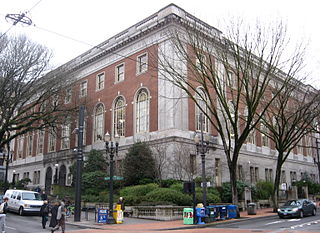
The Central Library is a three-story public library branch in downtown Portland, Oregon, United States. Opened in 1913, it serves as the main branch of the Multnomah County Library system. In 1979, the Georgian style building was added to the National Register of Historic Places as the Central Building, Public Library. The library underwent major structural and interior renovations in the mid 1990s.

The Failing Office Building is a building in downtown Portland, Oregon, United States that was listed on the National Register of Historic Places on October 31, 2007. The building was built during the rapid growth in Portland's business district after the Lewis and Clark Centennial Exposition in 1905. It was built with six stories in 1907, with a six-story addition in 1913. It features a reinforced steel-frame structure with facades of yellow brick and glazed terra cotta.

The Portland Hotel was a late-19th-century hotel in Portland, Oregon, United States, that once occupied the city block on which Pioneer Courthouse Square now stands. It closed in 1951 after 61 years of operation.

Whidden & Lewis was an architectural firm based in Portland, Oregon, in the United States, around the beginning of the 20th century, formed by William M. Whidden and Ion Lewis. The partnership was established in 1889. Their residential buildings were mostly in the Colonial Revival style, while their commercial buildings were primarily in the 20th-century classical style. The commercial buildings often featured brick, along with terra cotta ornamentation. Many of their buildings are listed on the National Register of Historic Places (NRHP).

The Wilcox Building is a building located in downtown Portland, Oregon, listed on the National Register of Historic Places. The building was designed by Whidden and Lewis. The design is similar to the Failing Office Building (1907) and Stevens Building (1914), also by Whidden and Lewis.

The Italian Gardeners and Ranchers Association Market Building, also known as the Italian Market, in southeast Portland, Oregon in the U.S. is a two-story commercial structure listed on the National Register of Historic Places. Built of concrete in 1922, it was added to the register in 1989.

The Blake McFall Company Building, also known as the Emmett Building, in southeast Portland in the U.S. state of Oregon, is a five-story commercial warehouse listed on the National Register of Historic Places. Designed by McNaughton & Raymond of Portland and built in 1915, it was added to the register in 1990. The 100-by-200-foot structure is representative of a group of timber-framed loft warehouses built in the early 20th century on the east side of the Willamette River.

The Merchant Hotel, also known as the Merchants' Hotel, is a historic former hotel building in Portland, Oregon, United States. It is located at 121 N.W. Second Avenue in Old Town Chinatown. It is a contributing property in the Portland Skidmore/Old Town Historic District, which was listed on the U.S. National Register of Historic Places in 1975 and designated a National Historic Landmark District in 1977. It is one of the few remaining examples of Victorian Italianate, cast iron architecture on the West Coast. It occupies half of a city block, specifically along the south side of N.W. Davis Street from Second to Third Avenues.
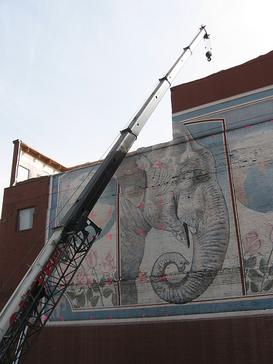
The Packy mural was a public artwork depicting the elephant of the same name, painted on the Skidmore Fountain Building in Portland, Oregon's Old Town Chinatown neighborhood. The artwork was designed by Eric Larsen and painted in 1990 by North Pacific Sign and Design, but was destroyed during the building's 2008 renovation to become the new headquarters for Mercy Corps.

The Railway Exchange Building is a historic building in Portland, Oregon, also known as the Oregon Pioneer Building. The structure houses the restaurant Huber's.

Glenn Stanton (1895–1969) was an American architect in practice in Portland, Oregon, from 1925 until 1969. From 1951 to 1953 he was president of the American Institute of Architects.